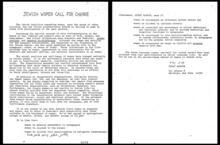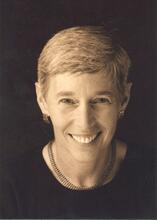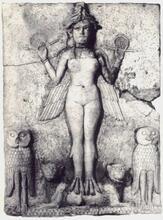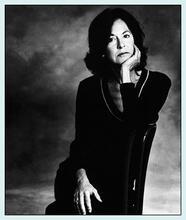Midrash and Aggadah: Introduction and Sources
The Midrash and Aggadah are expansions of the biblical narrative composed by the Rabbis in the first centuries C.E. The writings of the Rabbis in these works offer detailed depictions and analyses of women who appear only briefly or not at all in the Bible. The Rabbis portray women as able to be scholars and decision-makers with influence over men. The 75 Encyclopedia articles about women in the midrash analyze the language of the Rabbis to compare their opinions to the full biblical text and to contextualize aggadic traditions.
Introduction
This Encyclopedia presents the portraits of seventy-five women in the Bible as they appear in the aggadic and midrashic expansions of the Biblical narrative that were composed by the Rabbis in the first centuries C.E., in The Land of IsraelErez Israel and in Babylonia.
Rabbinic Descriptions of Women
Our treatment of these exegeses is unique and differs markedly from previous works (e.g., Louis Ginzberg, Legends of the Jews; Hayyim N. Bialik and Yehoshua H. Rawnitzki, Sefer ha- Statements that are not Scripturally dependent and that pertain to ethics, traditions and actions of the Rabbis; the non-legal (non-halakhic) material of the Talmud.Aggdah [The Book of Legends]; James L. Kugel, Traditions of the Bible) in its focus on the Biblical characters themselves, and not on the plot of the Biblical narratives. Collecting the aggadot relating to a single character provides a fresh look at this midrashic material, along with an intriguing portrait of the character, as seen through the eyes of the Rabbis. While at times the female characters play only a minor role in the Biblical drama, they are the subject of a great deal of aggadic material. In the midrashim they become vivid flesh-and-blood creatures who captivate the reader; they assume form and image, with clearly delineated personalities, and their voices are heard. The Rabbis frequently create characters that are absent from the Bible (such as the wife of Korah; the wife of On Ben Peleth); others, whom the Bible mentions only by name and no more, are the subject of abundant and rich traditions (e.g., Serah daughter of Asher; Bithiah daughter of Pharaoh).
The Rabbinic discussions of the women in the Bible reveal human reality in all its aspects. The picture that unfolds before us is more profound and diverse than that which emerges from the sources that directly address the issue of the status of women. At times the women of the Bible are portrayed by the Rabbis as dominant figures, who influence their husbands and the future of their families. They initiate and act, in the male sphere as well, and serve as leaders who set the tone for society. Some women are even depicted as scholars who publicly teach the law. These descriptions present an additional perspective, one that differs from the declarative Rabbinic dicta concerning women and femininity in which the woman is frequently presented as marginal in society.
Format of Encyclopedia Articles
The entries in the Encyclopedia collect the aggadic material on these women from the Rabbinic literature. This is not an attempt to follow the development of the traditions regarding any specific figure, but to present the plethora of aggadot and the diversity of views concerning each character. Unlike similar collections in the past, here the Rabbinic approaches are cited without any inclusion of aggadic traditions from the apocryphal or Christian literatures. The complete picture of the character that is constructed solely from the Rabbinic sources differs from the portrait resulting from the incorporation of those other traditions.
The language of the Rabbis is unique and finely crafted and includes puns and repetitions. One of the goals in writing these entries was to preserve the language of the A type of non-halakhic literary activitiy of the Rabbis for interpreting non-legal material according to special principles of interpretation (hermeneutical rules).midrash as much as possible, within the restraints imposed by translation. Divergences from the original midrashic language have been introduced in the interests of clarity, in order to explain the enigmatic language of the sources. The texts of the aggadot are taken from the scientific editions of the midrashim.
An additional aim was to show how the aggadot rely on and emerge from the Biblical prooftexts. Rabbinic dicta are usually set forth in relation to Biblical verses, using the letters, words, and grammar of the verse on which the aggadic tradition is based. This method of presenting Rabbinic aggadot opens a window to the way of thinking of the Rabbis and their rich imagination, and to the way in which they perceived the written word.
One of the central characteristics of Rabbinic literature is that a single aggadic tradition recurs in different compositions. In such instances, we chose a single tradition that provides the most complete picture of the aggadah, while preferring early to later sources. When there was a significant difference between the parallel traditions, the parallel was cited as “another tradition,” alongside the first.
The midrashic material concerning each character is organized in accordance with significant milestones in the life of the individual, her activity ,and her annals. The entries include most of the aggadic traditions relating to each of the characters, with omissions or condensations as required by the format of the Encyclopedia. The latter is especially the case for those characters for whom there is a large body of midrashic material. For this reason, no mention is made of previous studies written on the various individuals.
Together with and following some of the aggadic traditions, we have added explanations or comments that explicate the aggadah and place it within the richly textured fabric of the Rabbinic world. For the characters for whom a great deal of material exists, the entry usually begins with a short summary.
The Rabbinic attitude to the women of the Bible is fascinating and reveals a new, and as yet unexamined, aspect of the Rabbis’ thoughts on women and femininity in general. The profound and complex picture that emerges from these traditions constitutes an important contribution to the study of women’s status and gender studies.
The editions used for the sources for which scientific editions have been published were preferred. Unless specified otherwise, these editions are in Hebrew.
Aggadat Bereshit, ed. Buber: Agadath Bereschith. Midraschische Auslegungen zum ersten Buche Mosis. ... mit einer Oxforder Handschrift cod. 2340 herausgegeben (Cracow, 1903 [photocopy ed.: Jerusalem, 1973]).
Avoth de-Rabbi Nathan, Solomon Schechter Edition, with references to parallels in the two versions and to the addenda in the Schechter edition, olegomenon by Menahem Kister (New York, 1997).
BT (Babylonian Talmud) (Vilna, 1912).
Cant. Rabbah: Shir ha-Shirim Rabbah (Vilna, 1887).
Deut. Rabbah ed. Lieberman, Deuteronomy Rabbah; Midrash Debarim Rabbah: Edited for the first time from the Oxford ms. No. 147 ...2, ed. S. Liebermann (Jerusalem, 1992).
Deut. Rabbah, Deuteronomy Rabbah (Vilna, 1887).
Esth. Rabbah, Esther Rabbah (Vilna, 1887).
Ex. Rabbah, Exodus Rabbah, ed. Shinan: Midrash Shemot Rabbah. Chapters I-XIV: A Critical Edition Based on a Jerusalem Manuscript ..., ed. A. Shinan (Jerusalem and Tel Aviv, 1984).
Ex. Rabbah, Exodus Rabbah (Vilna, 1887).
Gen. Rabbah, Genesis. Rabbah, ed. Theodor-Albeck (Jerusalem, 1965).
Gen. Rabbati, ed. Albeck: Midraš Berešit Rabbati. ex Libro R. Mosis Haddaršan collectus e Codice Pragensi ..., ed. Ch. Albek (Jerusalem, 1940).
JT (Jerusalem Talmud).
Lam. Rabbah, Lamentations Rabbah, ed. S. Buber (Vilna, 1899).
Legends of the Jews, L. Ginzberg (Philadelphia, 1954; English).
Lev. Rabbah: Midrash Vayyikra Rabbah: a critical edition based on manuscripts and Genizah fragments with variants and notes3, ed. M. Margulies (New York and Jerusalem, 1993).
Mann, Fragments of the Palestinian Order of Service:
Mann, Jacob. "Fragments of Midrashim on Genesis and Exodus from Geniza Manuscripts," The Bible as Read and Preached in the Old Synagogue: A Study in the Cycles ..., vol. 1, Hebrew section. (Cincinnati: 1940; New York: 1971).
Mekhilta de-Rabbi Ishmael: Mechilta d'Rabbi Ishmael2, eds. H. S. Horowitz and I. A. Rabin (Jerusalem, 1970).
Mekhilta de-Rabbi Simeon bar Yohai: Mekhilta d'Rabbi Sim'on b. Jochai2, eds. J. N. Epstein and E. Z. Melamed (Jerusalem, 1979).
Midrash Abba Gurion, ed. Buber, Midrash Panim Aherim, ed. Buber: Sammlung Agadischer Commentare zum Buche Ester. Enhalt: Midrasch Abba Gorion, Midrasch Ponim Acherim; Midrasch Lekach Tob, ed. S. Buber (Vilna, 1894).
Midrash Aggadah, ed. Buber: Agadischer Commentar zum Pentateuch nach einer Handschrift aus Aleppo, ed. S. Buber (Vienna, 1894).
Midrash ha-Gadol, Genesis: Midrash Haggadol on the Pentateuch. Genesis: Edited from various manuscripts3, ed. M. Margulies (Jerusalem, 1997).
Midrash ha-Gadol, Exodus: Midrash Haggadol on the Pentateuch. Exodus: Edited from various manuscripts3, ed. M. Margulies (Jerusalem, 1997).
Midrash ha-Gadol, Leviticus: Midrash ha-Gadol on the Pentateuch, composed by Rabbi David ben R. Amram Adani2, ed. A. Steinsaltz (Jerusalem, 1997).
Midrash ha-Gadol, Numbers: Midrash Haggadol on the Pentateuch. Numbers: Edited from various manuscripts2, ed. Z. M. Rabinowitz (Jerusalem, 1997).
Midrash ha-Gadol, Deuteronomy: Midrash Haggadol on the Pentateuch. Deuteronomy: Edited for the first time from various manuscripts2, ed. S. Fisch (Jerusalem, 1997).
Midrash Proverbs: Midrash Mishle, ed. B. L. Visotzky (New York, 1990).
Midrash Samuel, ed. Buber: Midrasch Samuel; agadische Abhandlung über das Buch Samuel, ed. S. Buber (Cracow, 1893 [photocopy ed.: Jerusalem, 1968]).
Midrash Tannaim, Deuteronomy: Midrasch Tannaïm, ed. D. Hoffmann (Berlin, 1908-1909).
Midrash Tehillim, Sekhel Tov, ed. Buber: Midrasch Tehillim (Schucher Tob), ed. S. Buber (Vilna, 1891 [photocopy ed.: Jerusalem, 1977]).
Milikowsy, C.J. " [Seder Olam: A Rabbinic Chronography," Ph.D. diss., Yale University, 1981.
M (Mishnah): Shishah Sidrei Mishnah, ed. Ch. Albeck (Jerusalem and Tel Aviv, 1988).
Num. Rabbah, Numbers Rabbah (Vilna, 1887).
Ozar ha-Midrashim (Ozar Midrashim), ed. J. D. Eisenstein (New York, 1928).
Pesikta Rabbati: Pesikta Rabbati, ed. M. Friedmann (Ish-Shalom) (Vienna, 1890).
Pesikta re-Rav Kahana: Pesikta de Rav Kahana: according to an Oxford manuscript ...2, ed. B. Mandelbaum (New York, 1987).
Pirkei de-Rabbi Eliezer: "Pirkei de-Rabbi Eliezer," ed. M. Higger, Horeb (1944-1948).
Ruth Rabbah (Vilna, 1887).
Seder Eliyahu Rabbah and Seder Eliyahu Zuta: Seder Eliahu Rabba and Seder Eliahu Zuta (Tanna d'be Eliahu). Pseudo-Seder Eliahu Zuta: According to a Ms. edited with Commentaries and Additions, ed. M. Friedmann (Ish-Shalom) (Vienna, 1904 [photocopy ed.: Jerusalem, 1969]).
Shir ha-Shirim Zuta: Midrash Shir ha-Shirim, Ruth, Echah and Koheleth2, ed. S. Buber (Vilna, 1925).
Sifrei on Numbers and Sifrei Zuta, ed. H. S. Horovitz (Jerusalem, 1992).
Sifrei on Deuteronomy ed. L. Finkelstein (New York and Jerusalem, 1993).
Soferim: Masekhet Soferim, ed. M. Higger (New York, 1937).
Tanhuma, ed. Buber; ed. S. Buber (Lemberg, 1884 [photocopy ed.: Jerusalem, 1964]).
Tanhuma (Mantua, 1523 [photocopy ed.: Jerusalem, 1971]).
T Tosefta):
The Tosefta: according to Codex Vienna, with Variants from Codices Erfurt, London, Genizah MSS. and Editio Princeps (Venice 1521) ..., ed. S. Lieberman (New York, 1955-1988).
Tosefta: Based on the Erfurt and Vienna Codices ...4, ed. M. S. Zuckermandel (Jerusalem, 1975).
Yalkut Shimoni (Prophets and Writings), vol. 3 (Salonika, 1521 [photocopy ed.: Jerusalem, 1973]).










